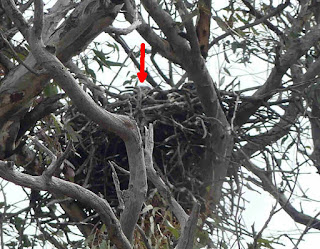The Magnificent 7 do Baroona Rd
7 members didn’t believe the BoM weather forecast and
gathered at Baroona Rd for a guided tour by one of the owners of Illilanga of
their property and the adjoining wetland.
While the wind was a tad gusty there was not a drop of rain during the
outing!
We began with a loop around a woodland remnant particularly notable
for interesting nest sites. These
included White-faced Heron (Occupied Nest); Brown Falcon (Nest with Young - the arrow points to the eyass' head);
Yellow-rumped
Thornbill (Carrying Food); Easter Rosella and Common Starling (both Inspecting Hollow,
with some disputation over ownership);
and Dusky Woodswallow (Occupied Nest).
Less common species observed, but not undertaking breeding
activity , were Speckled Warbler,
and male White –winged Triller. What was thought to be a Rufous Songlark (interestingly silent and on the ground rather than noisily flying from treetops) was subsequently identified from a photo in the checklist as a female Triller. (I always have trouble identifying females of that species - at least on this occasion several others had the same problem!) The only cuckoo observation was a brief call
by Horsfields Bronz-Cuckoo. A full list
of the 28 27 species seen at this site is here.
We then proceeded to the large wetland on an adjacent
property being developed as wildlife habitat.
A large number of trees have planted and are watered - at least monthly - from the dam.
Livestock in the area were fenced off from the plantings and included donkeys
and alpacas
The big-ticket item in this wetland was a male Musk Duck and he duly
appeared (and as is normal for this species disappeared frequently beneath the
water).
The only breeding activity
recorded in this site was Golden-headed Cisticola where chicks were heard
begging in a bramble when an adult entered the bush.
Less common species seen here also included 2
Black-fronted Dotterels seen on mud banks in the larger water
body
A small number of Common Mynas were seen, associating with horses after we'd left the dam.
Presumably they dine on the McDonalds etc trash dropped along the Highway to get out of Canberra and then take up residence where they can forage in the horse apples.
Overall we recorded 39 species for the day.















Comments